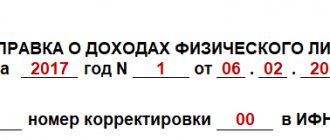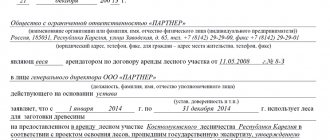One of the integral elements of the OSN is the estimated income of an individual entrepreneur. Based on this information, the Federal Tax Service Inspectorate calculates the amount of advance payments required to be paid by individual entrepreneurs under this taxation system. In accordance with the Tax Code of the Russian Federation, an individual entrepreneur must independently calculate the expected income, enter the obtained data into Form 4-NDFL and submit it to the Federal Tax Service.
From our material today, the reader will learn about the rules for filling out this document, deadlines for its submission, and other important issues. At the bottom of the page you can find 4-NDFL 2020 and a sample of how to fill it out.
Essence of the report
Form 4-NDFL is required to be submitted by individual entrepreneurs using SOS. Of all tax returns, the 4-NDFL declaration is the smallest in volume, only one page. The declaration is submitted after receiving the first income of the year. In the document, the individual entrepreneur must indicate the income he plans to receive during the current year. Subsequently, based on these data, the Federal Tax Service Inspectorate calculates the amount of quarterly advance payments for personal income tax and sends them to the entrepreneur.
If in the future the actual income turns out to be more than 50% more or less than the income indicated in 4-NDFL, it is necessary to send a new form to the Federal Tax Service to adjust the amount of advance payments.
At the end of the year, the individual entrepreneur must submit a report on the OSN in form 3-NDFL.
What is it and who rents it?
Until 2020, individual entrepreneurs had to submit a declaration in form 4-NDFL on the general taxation system after receiving their first income in the year (from the moment the application of the OSN began or the transition to it).
In 4-NDFL, the entrepreneur indicated the estimated income for the year that he planned to receive (minus expenses). Based on this information, the Federal Tax Service calculated and sent payment slips to individual entrepreneurs for the payment of quarterly advance payments for personal income tax.
It was necessary to resubmit 4-NDFL if the income received during the year differed significantly (by more than 50%) from that indicated in the previously submitted declaration. This was necessary for accurate calculation (adjustment) of advances payable.
At the end of the year, entrepreneurs on OSNO must submit a 3-NDFL declaration.
Who hands it over and in what cases?
The following categories of business entities (those who have chosen the general taxation system) are required to submit a declaration to the regulatory authorities at the place of registration:
- Individual entrepreneurs who have just registered as business entities.
- Individual entrepreneurs who have been carrying out their commercial activities in any business area for a long time, and their income has either decreased by half or increased by 50%.
- Individuals who provide services to Russian citizens and taxpayers. This category includes lawyers, notaries, etc.
The subject can personally submit a completed and certified declaration to the regulatory authorities or send it by mail. It is possible to submit a report by e-mail, but after a pre-filled application (this can be done on the official website of the Federal Tax Service of Russia).
What are the deadlines for submitting 4-NDFL in 2020?
Declaration 4-NDFL is provided to tax authorities:
1. A newly registered business entity on OSNO - no later than 5 days after the expiration of a month from the date of receipt of the first income.
Based on the received declaration, the Federal Tax Service accrues (clause 8 of Article 227 of the Tax Code of the Russian Federation) advance payments for personal income tax to the entrepreneur for certain clause 9 of Art. 227 of the Tax Code of the Russian Federation, settlement periods:
- January June;
- July-September;
- October December.
Advance payments are due by the 15th day of the month following the last month of the billing period.
2. An economic entity that has previously received income and declared estimated revenue in Form 4-NDFL - when it is established that the amount of actual income has changed relative to the expected one, which was previously reflected in the declaration, by more than 50%.
The deadlines for submitting 4-NDFL in 2020 under the second scenario are not established by law (as well as for what period to determine the change in actual income relative to the expected one). The Federal Tax Service in letter dated November 14, 2006 No. 04-2-02/ [email protected] advises sending 4-NDFL on changed income for the current year together with 3-NDFL for the previous tax period.
We consider it legitimate to recommend sending the updated Form 4-NDFL to the Federal Tax Service 35 days before the deadline for paying the advance, because:
- The Federal Tax Service recalculates advances within 5 days after receiving the updated form 4-NDFL (clause 10 of article 227 of the Tax Code of the Russian Federation);
- The Federal Tax Service sends a notification with the calculated advance payment 30 days before the due date for its payment (Clause 2 of Article 52 of the Tax Code of the Russian Federation).
Thus, the recommended frequency of filing 4-NDFL contributes to the correct calculation of advances.
What is the difference between 4-NDFL and 3-NDFL?
Chapter 23 of the Tax Code of the Russian Federation mentions two types of reporting. The main legislator recognizes the 3-NDFL form. This declaration contains information about the income actually received, deductions and the amount of tax payable to the budget. The document includes a large number of sheets. Filling it out often raises questions among entrepreneurs and requires the involvement of a qualified accountant.
Form 3-NDFL is prepared at the end of the year. Entrepreneurs reflect in it both profit from commercial activities and third-party remuneration. Businessmen must submit the declaration before the end of April following the reporting year. Information is entered upon fact. The tax authority can only check the transfer of funds to the budget and assess the validity of the benefits used by the payer.
The 4-NDFL report is sent to regulatory authorities to report expected income. The difference lies in the probabilistic nature of the indicators. The declaration cannot replace 3-NDFL, but advance payments are calculated on its basis. This is a kind of reference point for inspectors.
Entrepreneurs do not need to regularly submit data on expected income. Subsequently, 4-NDFL replaces the annual report. The corresponding explanations were given by experts from the Russian Ministry of Finance in letter No. 03-04-07-01/47.
How to calculate projected income
The legislation gives individual entrepreneurs the right to independently determine what exactly to include in receipts. This is enshrined in paragraph 8 of Article 227 of the Tax Code.
Sample of filling out 4-NDFL
Sample of filling out 4-NDFL. Page 2.
Sample of filling out 4-NDFL. Section 3.
Advice: it is advisable not to underestimate forecast indicators. Federal Tax Service employees are suspicious of entrepreneurs whose revenue significantly exceeds the amount indicated in the “Four Personal Income Tax” certificate.
There are two methods to solve the problem:
- focus on monthly receipts (minus expenses);
- based on the data of the 3-NDFL declaration for the previous period.
Example
The first receipts to the account of IP Vanyushkin came on 03/03/2017. He began working on OSNO on the first day of the specified month.
This person must submit the forecast form to the Federal Tax Service by April 10, 2017. The calculation logic is as follows:
- in a month he earned 120 thousand rubles;
- the reporting period includes 10 months (from March to December);
- 120 thousand rubles. x 10 months = 1.2 million rubles.
For information: if an entrepreneur shows a forecast, the amount of which is significantly lower than the results of the previous year, then the inspector will calculate the advance tax based on data from 3-NDFL for the previous period.
Why was this form needed?
Declaration 4-NDFL was needed so that the tax office could calculate advance payments for personal income tax. Estimated income was taken as a basis to inform the entrepreneur how much money the budget expects from him each quarter. Because individual entrepreneurs on OSNO pay personal income tax not once a year, but in parts throughout the year, and then pay the rest.
That is, the newly registered individual entrepreneur informed the tax inspectorate: in 2020 I plan to earn 500 thousand rubles. And the tax office calculated his advance payments for the current year.
The next year, for advance payments, they took a declaration of real income - in form 3-NDFL. If the individual entrepreneur has been working for more than a year and the income has not changed dramatically, 4-NDFL was not required to be filed.
Deadlines for submitting 4-NDFL in 2020
In accordance with paragraph 7 of Art. 227 of the Tax Code of the Russian Federation, the report must be submitted no later than five working days after the end of the month in which the first income of the year was received. This rule applies to newly registered individual entrepreneurs. It doesn’t matter on what date the individual entrepreneur was registered; When filing 4-NDFL, you must start from the month you received your first income.
For example: an individual entrepreneur was registered with the Federal Tax Service on March 20, 2020, and the individual entrepreneur received his first income on October 4, 2020. It is from the last day of October that you need to calculate 5 working days and submit the 4-NDFL declaration no later than the 5th day. For individual entrepreneurs who have been engaged in entrepreneurial activity for more than a year, the Tax Code of the Russian Federation does not provide for exact deadlines.
Letter of the Federal Tax Service of the Russian Federation No. 04-2-02/685 dated November 14, 2006 contains a recommendation to submit 4-NDFL simultaneously with the 3-NDFL report. Those. until 30.04 of the year following the reporting year.
The legislation does not provide any deadlines for submitting an updated declaration
.
Attention should be paid to the situation when an individual entrepreneur did not submit an application for the application of the simplified tax system and applied UTII, and then, after a period of time, implemented another type of activity that does not fall under UTII. In this case, the new type of activity will be taken into account as income on OSNO. Therefore, an individual entrepreneur is obliged to submit a 4-NDFL declaration on time according to the general rule described above.
Responsibility for late submission of the report
If the report is not submitted on time, the individual entrepreneur may be fined 200 rubles, in accordance with Art. 126 of the Tax Code of the Russian Federation.
There are known cases of bringing entrepreneurs to administrative liability under Art. 119 of the Tax Code of the Russian Federation. But such actions by the Federal Tax Service are unlawful, since 4-NDFL contains information about estimated income, the imposition of a fine on which is illegal. In such a situation, such actions of the Federal Tax Service as blocking a current account are also unlawful.
Therefore, fines based on estimated income can be appealed through a pre-trial audit. To do this, a complaint is filed with the Federal Tax Service and the Federal Tax Service.
Sanctions for failure to submit a declaration
Federal legislation of Russia obliges individual entrepreneurs to generate a 4-NDFL report and submit it within the established time frame to local regulatory authorities (business entities must submit this report at least once). But it is worth noting that the Tax Code does not provide for any liability for violators of the regime in the form of penalties, which are calculated as a percentage of underpaid taxes to the budget.
About fines
Punishment for failure to submit reports on time is provided for in Article 119 of the Tax Code. In particular, its text links the size of the fine with the arrears. This point of law is not applicable to the report described. After all, it contains only a forecast, which is not the amount of actual profits received.
Therefore, punishment for violation of deadlines is applied in accordance with Article 126 of the Tax Code:
- if the primary form is not submitted, then a fine of 200 rubles is imposed;
- If a lack of adjustment is identified, no penalty will be applied.
How is the declaration submitted?
The report in form 4-NDFL must be submitted to the Federal Tax Service at the place of registration of the entrepreneur. You can do this in one of three ways. Namely:
In electronic form through electronic document management operators or through the official website of the Federal Tax Service.
In paper form in person or through a representative. In this case, two copies must be submitted to the Federal Tax Service. One will be submitted to the tax service, the second with an acceptance stamp will be returned to the entrepreneur as proof of his submission of this declaration. If the report is submitted by a representative, a power of attorney must be issued for it by a notary.
A valuable letter with an inventory of the contents by Russian post. The description of the attachment must indicate the declaration being sent. The inventory, as well as the payment receipt, must be kept. The date on the receipt is considered the date the document was submitted to the Federal Tax Service.
Form 4-NDFL from 2020: form
The 4-NDFL report is a one-page document that reflects the following information:
- TIN of the entrepreneur;
- Correction number (primary – 0, clarifying the order of the number series – 1, 2, etc.);
- Federal Tax Service code at the place of residence of the individual entrepreneur;
- The period for which the planned income is reflected;
- Payer code – the category to which it belongs. For example, the code for individual entrepreneurs is 720, for private practitioners - 730, for lawyers who have established their own office - 740;
- OKTMO code, i.e. the code of the territory where the entrepreneur operates;
- Full name of the entrepreneur;
- His phone number;
- The amount of expected income for the year;
- If supporting documents are available, fill in the field for the number of application sheets;
- Confirmation of the accuracy of the information is carried out in the section located in the lower right corner of the form. When submitting a declaration by the taxpayer himself, code 1 is entered in the designated field, the full name lines are not filled in, the filing date is indicated and the form is signed by the individual entrepreneur. When certifying the authenticity of information, the businessman’s representative enters code 2, his full last name, first name and patronymic are recorded in the full name field, and below is the name of the document giving him the authority to represent the payer. If the representative of the declarant is an enterprise, then the full name field reflects the full name of the representative for whom the power of attorney is issued, and in the line “Name of organization” the name of the company is recorded and certified by its seal and signature of the authorized representative.
Read also: New form 4-NDFL – 2019
Rules for filling out 4-NDFL
Official instructions for filling out the report are available for download using the button below:
The following are the basic rules for filling out the document:
- the report can be completed on a computer and printed or completed by hand;
- when filling out on a computer, the data is entered in capital letters in Courier New font size 16-18;
- when filling out by hand, the data must be entered in capital block letters;
- You can fill out the report by hand using a pen with blue or black ink;
- When filling out a document on a computer, the data must be aligned to the right;
- a dash is placed in unfilled report cells;
- It is not allowed to make corrections, use putties or staple the report sheets.
Calculation of estimated income
To complete the report in question, you must calculate your estimated annual income. The calculation principles for individual entrepreneurs who have been doing business for more than a year and for newly registered individual entrepreneurs may differ:
1. Newly registered individual entrepreneurs are calculated based on the amount of income received in the first month after registration.
2. If an individual entrepreneur has been engaged in entrepreneurial activity for more than a year , then the amount of income recorded in the 3-NDFL report for the previous year can be used as the estimated income.
In each case there are nuances.
Newly registered individual entrepreneurs
In this case, the report includes information about the income received during the first month. The calculation is quite simple.
Example. A.I. Ivanov registered as an individual entrepreneur on January 15, 2018. The entrepreneur received his first income on March 25, 2018. The amount of his income for this month (minus expenses) amounted to 100,000 rubles. To get the amount of estimated annual income, you need to multiply 100,000 rubles by the number of months remaining in the year:
100,000 rubles X 10 months = 1,000,000 rubles.
Individual entrepreneurs who have been operating for several years
If a person has been engaged in entrepreneurial activity for more than a year, then the amount recorded in the 3-NDFL report for the previous year can be taken as the estimated annual income.
If, in the opinion of the individual entrepreneur, his income this year will be less than last year, he has the right to indicate the amount he considers necessary.
At the same time, according to the letter of the Ministry of Finance of the Russian Federation dated 01.04.08 No. 03-04-07-01/47, if the amount of expected income in 4-NDFL differs from the amount in 3-NDFL by less than 50%, the Federal Tax Service will calculate advance payments based on 3-NDFL for last year.
Deadline for submitting the declaration
Form 4-NDFL for individual entrepreneurs on OSNO, the deadlines for submission of which are not strictly fixed, are used for reporting to the tax office in the following cases:
- when switching from another taxation regime to a general one;
- 5 days after the completion of the month from the date of receipt of the first profit;
- if the real income differs by one and a half times from the previously declared or indicated in the 3-NDFL report.
3-NDFL for individual entrepreneurs - what is it, sample form and when to submit
Regardless of the time of registration of the business, a properly completed declaration must be submitted to the Federal Tax Service within 5 working days a month after it began to generate profit. For example, an individual entrepreneur registered with the tax service in March, but received the first dividends only in October.
Important! He will have to submit his reports in November.
The legislation does not specify the deadlines for filing a declaration when switching to OSNO from another taxation system, although they usually follow the principle of submitting a report within a specified period of time. Specific fixed deadlines for detailed reports are not indicated due to the fact that they must be provided in the event of changes in indicators.
The exact deadlines for submitting the declaration are established only for beginners. Everyone else can take their time, but they should take into account the time required by the Federal Tax Service employees to calculate advance payments and send a notice of payment before the due date (July 15, October and January).
How to calculate and fill out 4-NDFL
Report structure
Declaration 4-NDFL contains only one sheet with a simple structure.
At the top of the document there is a field for entering the TIN.
In the “correction number” item the following is entered:
- the number “0” if the individual entrepreneur submits a report for the first time this year;
- the number “1” or more if the individual entrepreneur submits a report clarifying the expected income. In this case, the number means the number of the clarification being submitted.
The “tax period” section indicates the year for which the report is submitted.
The paragraph “submitted to the tax authority” indicates the code of the Federal Tax Service to which the declaration is submitted.
In the item “taxpayer category code” you should enter the numbers “720”, indicating that the document is being submitted by an individual entrepreneur.
For other categories of individual entrepreneurs the following codes are established:
- 730 Notary engaged in private practice and other similar persons;
- 740 Lawyer who opened a law office;
- 770 An individual is an individual entrepreneur who is the head of a peasant (farm) enterprise.
In the item “OKTMO code” the code of the territory where the person is registered as an individual entrepreneur is entered.
Item “F.I.O. and telephone" is used to indicate this data. They must be written in full without abbreviations.
The “amount of estimated income” item is used to indicate the expected income. Data must be entered in whole monetary units without dashes, brackets or any punctuation marks.
Procedure for calculating estimated income
There is no official methodology for calculating the estimated income indicated in the 4-NDFL declaration. However, regulatory authorities explained how to calculate such income. An entrepreneur can reduce the first income received during a month by expenses incurred during the same period. The resulting difference should then be multiplied by the number of months remaining until the end of the calendar year.
Rules and procedure for filling out the form
When filling out the 4-NDFL declaration, individual entrepreneurs working on the general system must be guided by the current Federal legislation of Russia, in particular the order of the Tax Service No. MMB - 7 - 3 / [email protected] dated December 27, 2010 (with all changes made as of November 14 .2013).
Here you can find a sample of this form
The report contains personal information about the entrepreneur and contains the following data:
- Full name of the business entity.
- Tax identification number, which is assigned to each taxpayer (in this case, the individual entrepreneur will indicate the code he received from the Federal Tax Service as an individual).
- Document code. To fill out this window, you must use the appropriate Directory.
- Code of the tax authority to which the declaration is submitted.
- Contact phone number (both landline and mobile numbers can be indicated).
- The amount of income that an individual entrepreneur expects to receive in the reporting year.
- Information about the authorized person who, instead of the individual entrepreneur, submits a declaration to the regulatory authorities (if any).
- Series and passport number of the entrepreneur's representative.
- Date the report was completed.
- Taxpayer's signature and personal seal.
After entering the data, the date for filling out the report is indicated below, and this sheet is certified by the signature of the business entity.
When an individual entrepreneur fills out the form for the first time, he should indicate the number zero in the box called “adjustment number.” In the future, when submitting an updated declaration, you must enter a number in this field that will reflect the sequence of filing the report - 1, 2, 3, etc.
Possible problems during delivery
Some Federal Tax Service Inspectors, accepting reports in paper form, may require:
- print a two-dimensional barcode on the declaration that duplicates the information contained in the report;
- Attach a flash card or disk with the reporting file to the paper report.
It is noteworthy that the Tax Code in its current version does not contain such requirements. Meanwhile, there are cases where some Federal Tax Service Inspectors do not accept reports without fulfilling the above conditions. These demands are unlawful and can be appealed to a higher body of the Federal Tax Service.
According to the Letter of the Ministry of Finance of the Russian Federation dated April 18, 2014. No. PA-4-6/7440, the absence of a bar code, as well as an error in OKTMO are not grounds for refusal to accept tax reporting.
Draft order to abolish 4-NDFL
And now, news for those who must fill out form 4-NDFL.
A draft document on the cancellation of the order of the Federal Tax Service, which approved the 4-NDFL declaration, has been published on the federal portal.
How will we calculate tax after the abolition of 4-NDFL?
According to the rules prescribed in the new edition of paragraphs 7 and 8 of Art. 227 of the Tax Code of the Russian Federation, for those working at OSNO it will be necessary to independently calculate advance payments based on the results of the quarter, half a year and nine months. Advance payments will be calculated based on:
- tax rates;
- actual income received;
- professional and standard tax deductions;
- previously calculated advance payments.
The deadlines for making advance payments are April 25, July 25 and October 25.
This is a new edition of clauses 7 and 8 of Art. 227 of the Tax Code of the Russian Federation, and clauses 9 and 10 lost force (clause 7 of Article 1 of the Law of April 15, 2019 No. 63-FZ was introduced).
Difference from 3-NDFL
Many individual entrepreneurs wonder: what is the difference between the 4-NDFL form and the 3-NDFL form. To get the answer, you need to look at the table:
| Differences | 4-NDFL | 3-NDFL |
| Submission of information | expected financial result | data on income received for the reporting period (for the calendar year) |
| Who is required to submit | individual entrepreneurs, both new and long-established (those who have chosen the general taxation system), as well as individuals providing services privately | business entities, as well as individuals (ordinary citizens) who received any income during the reporting period |
| Why is the declaration submitted? | for analyzing business activities and calculating advance payments | for taxpayers to calculate the grounds for receiving social or property deductions |
This might also be useful:
- Tax calendar for 2020 for individual entrepreneurs
- Production calendar for 2020
- Increasing the minimum wage in 2020
- Act of joint reconciliation of taxes and fees with the Federal Tax Service
- What taxes does the individual entrepreneur pay?
- Tax system: what to choose?
Is the information useful? Tell your friends and colleagues
Dear readers! The materials on the TBis.ru website are devoted to typical ways to resolve tax and legal issues, but each case is unique.
If you want to find out how to solve your specific issue, please contact the online consultant form. It's fast and free!









